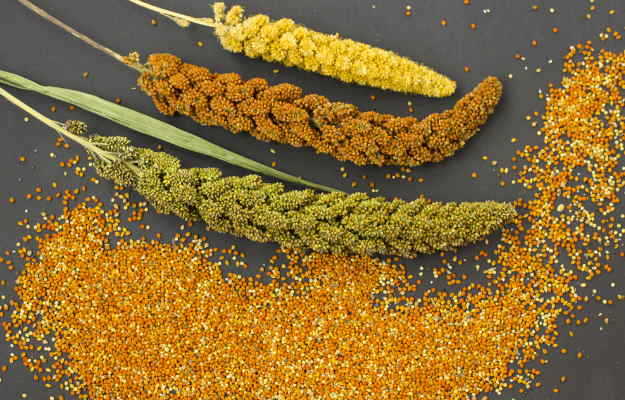There are many grains that are grown across the length and breadth of India and bajra or pearl millet is one of the key types. The western states of India are not only the key producers of bajra but also its key consumers. This whole grain - which may be white, brown, grey or even purple in colour - is now gaining popularity as a healthier alternative to starchy grains like white rice.
Like most grains, bajra is packed with dietary fiber, plant proteins, vitamins, minerals and phytonutrients. In fact, the proteins found in bajra are more potent than those in other grains like maize or corn. This makes it a dietary source of many vital nutrients and an important staple, especially for vegetarians and those who follow a vegan diet. However, bajra also contains high amounts of nitrates, phytic acid and oxalates, which can make its excess consumption bad for your health, especially if you have high blood pressure, malabsorption syndrome or are prone to kidney stones.
Did you know?
The crop bajra is believed to have originated in the Sahel region of Africa and the western part of India. These regions are known for their water scarcity and sandy or dry loamy lands, which makes bajra a key source of nutrition and one of the chief foods grown in these parts. These environmental factors for growth are some of the main reasons why this grain is so packed with nutrients.
Some basic facts about bajra:
- Botanical name: Pennisetum glaucum
- Family: Poaceae
- Common name: Bajra, pearl millets
- Sanskrit name: Priyangu, kandaja
- Parts used: Whole grain
- Native region and geographical distribution: India is the largest producer of bajra in the world. Rajasthan, Maharashtra, Haryana, Uttar Pradesh and Gujarat are key bajra-producing states.
Bajra nutrition facts
Bajra is a whole grain that is packed with many nutrients, including carbohydrates, plant proteins, vitamins, minerals and phytonutrients. According to a book published in 2017 titled Engineering Interventions in Agricultural Processing, the following are the nutritional facts for bajra or pearl millets.
| Nutrient | Value per 100 g |
| Energy | 378 kcal |
| Carbohydrates | 72.8 g |
| Dietary fiber | 8.5 g |
| Fat | 4.2 g |
| Protein | 11 g |
| Fatty acids, polyunsaturated | 2.1 g |
| Fatty acids, omega 6 | 2 g |
| Vitamins | |
| Vitamin B3 | 4.72 mg |
| Vitamin B9, Folate | 85 µg |
| Minerals | |
| Calcium | 8 mg |
| Iron | 3 mg |
| Magnesium | 114 mg |
| Manganese | 1.6 mg |
| Phosphorus | 285 mg |
| Sodium | 5 mg |
| Zinc | 1.7 mg |
Benefits of bajra
Whole grains are increasingly getting a reputation for being some of the best and holistic food sources available to humankind. Bajra is a nutrient-dense whole grain that is getting a lot of attention for its many health benefits. Apart from being packed with B vitamins and many minerals, bajra also contains antioxidants like phytates, phenols and tannins. These phytonutrients add to the nutritional value of bajra. The following are some of the key benefits you can gain from consuming bajra.
Bajra aids digestion
Bajra, like all millets, is packed with dietary fiber. Fiber is one of the most valuable nutrients for gut health as it helps maintain a balance between the diverse gut microbiota, helps keep the lining of the stomach and intestines safe and also improves bowel function. Including bajra in your diet can help you prevent constipation, diarrhea, indigestion, dysentery and other digestive health issues.
(Read more: How to improve digestion)
Bajra helps in weight loss
One of the main reasons why bajra is gaining popularity is due to the fact that it may aid in weight loss, especially as a substitute for unhealthy carbs in your weight loss diet. Bajra is low in calories but high in fiber, which can help you stay full for longer. The fiber in bajra can also aid your digestion and boost your metabolism in a way that can help you shed the kilos faster.
(Read more: 15 tried and tested ways to lose weight)
If you are tired of dieting and exercising and are not able to lose weight, then use myUpchar Ayurveda Medarodh Fat Burner Capsule, it has no side effects, order it today and avail the benefits.
Bajra may improve immune function
Bajra is not only packed with essential proteins, vitamins and minerals but also contains antioxidants that may work together to boost your immune system. Bajra contains flavonoids, which can not only bolster a weak immune system but also prevent free radical damage of the cells. The immune-boosting properties of bajra are also needed more during the winter months because it is a warming food that helps prevent the common cold and flu.
Bajra may improve diabetes control
Bajra has a low glycemic index at 54 and a glycemic load of 6.06. Both these numbers suggest that consuming bajra is unlikely to lead to a postprandial blood sugar spike. This, in turn, indicates that bajra can be safely consumed by those who have diabetes or prediabetes since people with these underlying health problems are recommended to only include low-glycemic-index foods in their diet.
(Read more: Diet for diabetes)
Bajra may improve skin health
Your skin, hair and nails require many micronutrients apart from protein to be able to grow properly and stay healthy. Bajra is chock full of all these micronutrients, including iron, zinc, vitamin B3, vitamin B6 and vitamin B9. This suggests that consuming bajra regularly may improve your skin, hair and nail health. However, more conclusive scientific evidence is required to establish a direct link between bajra consumption and skin quality improvements.
(Read more: Top 10 vitamins for women’s health)
Bajra improves muscle mass
The proteins found in bajra are high-quality plant proteins, packed with almost all the essential amino acids. This means that eating bajra regularly can help you build and maintain your muscle mass, especially if you are a bodybuilder or sportsperson. This may also help those at risk of developing or already suffering from malnutrition, protein deficiency and muscle loss or sarcopenia.
(Read more: Muscle weakness)
Bajra prevents gluten sensitivity
Bajra is a gluten-free grain, which means that it does not cause any gluten intolerance, gluten allergy or wheat allergy. The manufacturing process of bajra and bajra products does not require or involve the addition of other grains or flours. This ensures that bajra products are gluten-free and safe for consumption in moderate amounts for all those suffering from celiac disease or any other type of gluten-related problems.
(Read more: Gluten-free foods)
Side effects of bajra
Bajra is a nutrient-dense healthy food and safe for consumption for most. However, in some cases, excess consumption of bajra may also lead to some adverse effects. This is especially true for those who have an underlying health issue or are at risk of developing one that may be exacerbated by bajra consumption. The following are all the health problems that may be caused or worsened by bajra consumption.
Bajra may cause malabsorption syndrome
Bajra contains many phytonutrients or phytochemicals and a particular class of nutrients in this grain are also known as antinutrients. Antinutrients like phytic acid are plant compounds that impair the body’s ability to absorb essential nutrients and usually aren’t a cause for concern if you have a balanced diet without an excess of antinutrient-heavy grains and legumes. However, if you consume an excess of bajra, especially combined with legumes, lentils and other grains, then it may cause malabsorption syndrome and nutritional deficiencies in your body. This in turn could have far-reaching effects on your health.
Bajra may cause kidney stones
Bajra has high amounts of calcium and oxalates. These two compounds tend to accumulate in the body and create kidney stones in the long run, especially if the bajra is not properly washed and thoroughly cooked. If you already have kidney disease or bladder infection, then consult a doctor or nutritionist about your bajra consumption and avoid it if needed.
(Read more: Diet for kidney stones)
Bajra may worsen digestive disorders
Bajra is packed with dietary fiber, which is great for most people but a bane if you have a preexisting digestive disorder. If you have irritable bowel syndrome, inflammatory bowel disease or Crohn’s disease then consuming even small amounts of bajra may cause your intestinal and stomach linings to get inflamed. If you have any such digestive disorder, you should avoid bajra. If any symptoms of inflammation show up after consuming bajra, then consult your doctor to find out if you have any of these health issues.
Bajra may worsen thyroid dysfunction
Millets like bajra may contain high amounts of goitrogenic compounds like glucosylvitexin, glycosylorientin and vitexin. Consuming excess amounts of bajra may therefore impair your thyroid function primarily by impairing the absorption of iodine. If you eat too much bajra, you may be at risk of hypothyroidism, iodine deficiency and even goiter. Consult your doctor or nutritionist about the right amount of bajra you should be eating.
(Read more: Diet for hypothyroidism)
Takeaways
Bajra is a nutrient-dense, healthy whole grain and a good addition to your diet no matter where in the world you are from. It is one of the best replacements for white rice and unhealthy carbs. Bajra is also quite versatile and easy to cook, which means you can make a number of healthy recipes using it. Moreover, consuming bajra in moderate amounts regularly may also provide you with many health benefits including better weight management, blood sugar control, improved skin health and better lean muscle mass and health too.
However, if bajra is overconsumed or eaten when not properly cooked then it can cause a number of side effects too. Apart from leading to malabsorption syndrome, overeating bajra may also worsen kidney disease, digestive disorders and thyroid dysfunction. This is why consulting a doctor or nutritionist about your bajra consumption is very important. It is equally important that you wash the bajra thoroughly before cooking to flush out any toxins the grain may carry. Additionally, make sure you cook the bajra in a cooker so that it is properly cooked and not raw or undercooked when you eat it.
Find Nutritionist in cities
Doctors for Bajra : Nutrition facts, benefits and side effects

Dr. Dhanamjaya D
Nutritionist
16 Years of Experience

Dt. Surbhi Upadhyay
Nutritionist
3 Years of Experience

Dt. Manjari Purwar
Nutritionist
11 Years of Experience

Dt. Akanksha Mishra
Nutritionist
8 Years of Experience
References
- FoodData Central. United States Department of Agriculture. Washington D.C. USA; PEARL MILLET
- Food and Agriculture Organization of the United Nations, Rome, Italy. Annex I: Types of millet
- Pushparaj, Florence Suma and Urooj, Asna. Antioxidant Activity in Two Pearl Millet (Pennisetum typhoideum) Cultivars as Influenced by Processing. Antioxidants (Basel). 2014 Mar; 3(1): 55–66. PMID: 26784663
- Krishnan, Rateesh and Meera, MS. Pearl millet minerals: effect of processing on bioaccessibility. J Food Sci Technol. 2018 Sep; 55(9): 3362–3372. PMID: 30150794
- Boncompagni, Eleonora. et al. Antinutritional factors in pearl millet grains: Phytate and goitrogens content variability and molecular characterization of genes involved in their pathways. PLoS One. 2018; 13(6): e0198394. PMID: 29856884
- Tako, Elad. et al. Higher iron pearl millet (Pennisetum glaucum L.) provides more absorbable iron that is limited by increased polyphenolic content. Nutr J. 2015; 14: 11. PMID: 25614193
- Goyal, MR and Verma, DK. Nutritional value of Pearl Millet, Table 9. Engineering Interventions in Agricultural ProcessingPublisher: CRC Apple Academic Press, USA.











